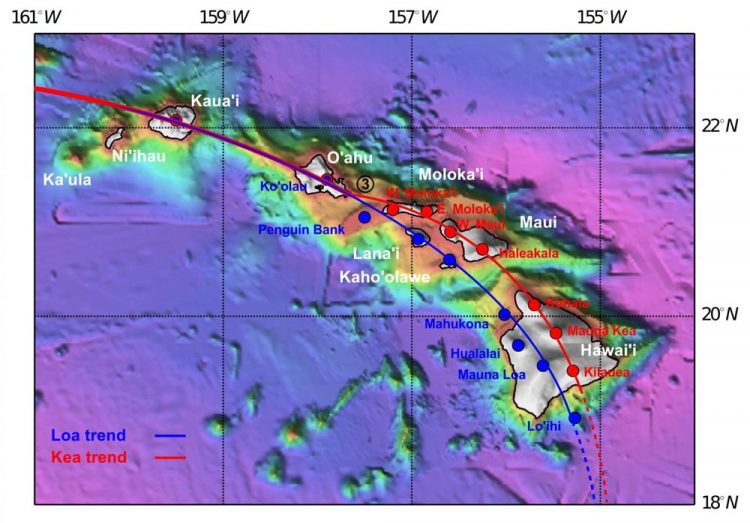Scientists discover how world's biggest volcanoes formed

This is a map of recent Hawaiian volcanism, highlighting the Loa and Kea tracks. Credit: Tim Jones, ANU
The study found that the volcanoes formed along twin tracks due to a shift in the Pacific Plate's direction three million years ago.
Lead researcher Tim Jones from ANU said scientists had known of the existence of the twin volcanic tracks since 1849, but the cause of them had remained a mystery until now.
“The discovery helps to better reconstruct Earth's history and understand part of the world that has captivated people's imagination,” said Mr Jones, a PhD student from the ANU Research School of Earth Sciences (RSES).
“The analysis we did on past Pacific Plate motions is the first to reveal that there was a substantial change in motion 3 million years ago. It helps to explain the origin of Hawaii, Earth's biggest volcanic hotspot and one of the most popular tourist destinations in the world.”
Twin volcanic tracks exist in other parts of the Pacific, including Samoa, and the study found that these also emerged three million years ago.
Mr Jones said this kind of volcanic activity was surprising because it occurred away from tectonic plate boundaries, where most volcanoes are found.
“Heat from the Earth's core causes hot columns of rock, called mantle plumes, to rise under tectonic plates and produce volcanic activity on the surface,” he said.
“Mantle plumes have played a role in mass extinctions, the creation of diamonds and the breaking up of continents.”
Co-researcher Dr Rhodri Davies from RSES said the twin volcanic tracks emerged because the mantle plume was out of alignment with the direction of the plate motion.
“Our hypothesis predicts that the plate and the plume will realign again at some stage in the future, and the two tracks will merge to form a single track once again,” Dr Davies said.
“Plate shifts have been occurring constantly, but irregularly, throughout Earth's history. Looking further back in time we find that double tracks are not unique to young Hawaiian volcanism – indeed, they coincide with other past changes in plate motion.”
Hawaii sits at the south-eastern limit of a chain of volcanoes and submerged seamounts which get progressively older towards the north west.
The researchers worked with the National Computational Infrastructure at ANU to model the Pacific Plate's change in direction and formation of the twin volcanic tracks through Hawaii.
###
The study is published in Nature.
For media assistance, contact Will Wright from the ANU Media Team on +612 6125 7979, +61 478 337 740 or media@anu.edu.au
Media Contact
All latest news from the category: Earth Sciences
Earth Sciences (also referred to as Geosciences), which deals with basic issues surrounding our planet, plays a vital role in the area of energy and raw materials supply.
Earth Sciences comprises subjects such as geology, geography, geological informatics, paleontology, mineralogy, petrography, crystallography, geophysics, geodesy, glaciology, cartography, photogrammetry, meteorology and seismology, early-warning systems, earthquake research and polar research.
Newest articles

First-of-its-kind study uses remote sensing to monitor plastic debris in rivers and lakes
Remote sensing creates a cost-effective solution to monitoring plastic pollution. A first-of-its-kind study from researchers at the University of Minnesota Twin Cities shows how remote sensing can help monitor and…

Laser-based artificial neuron mimics nerve cell functions at lightning speed
With a processing speed a billion times faster than nature, chip-based laser neuron could help advance AI tasks such as pattern recognition and sequence prediction. Researchers have developed a laser-based…

Optimising the processing of plastic waste
Just one look in the yellow bin reveals a colourful jumble of different types of plastic. However, the purer and more uniform plastic waste is, the easier it is to…



